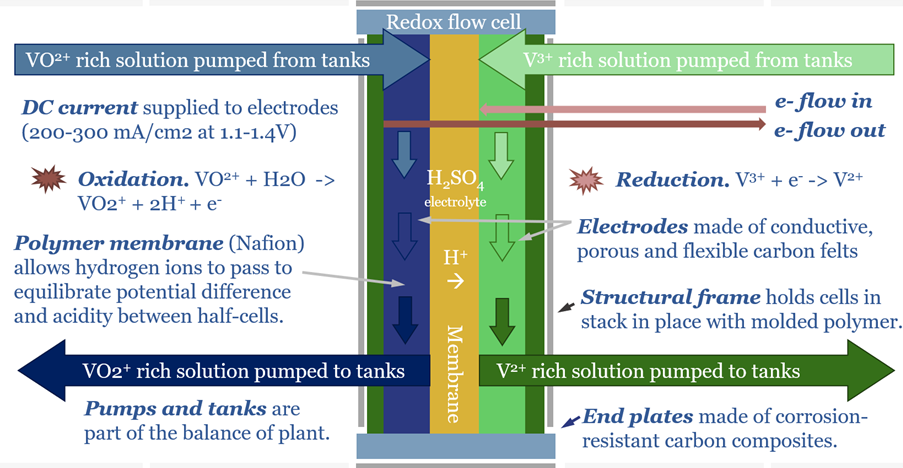Redox flow batteries have 6-24 hour durations and require 15-20c/kWh storage spreads. They will increasingly compete with lithium ion batteries in grid-scale storage. Does this unlock a step-change for peak renewables penetration? Or create 3-30x upside for total global Vanadium demand? This 15-page note is our outlook for redox flow batteries.
By now everybody knows that renewables have a volatile generation profile, which requires building backups, demand shifting, larger power grids, and energy storage.
Flow batteries are fundamentally different from lithium batteries. They store and re-release energy as two separate electrolytes oxidize and reduce, at two separate electrodes, either side of a permeable membrane.
The image above shows how a Vanadium flow battery is charged, storing up energy in the ‘higher energy’ V2+ and V5+ oxidation states. The cell simply runs in reverse to discharge.
There are many different types of flow batteries, but this note focuses on the current front-runner chemistry, using Vanadium as the key reagent, which can exist in oxidation states from 2+, 3+, 4+ and 5+. The technology is explained on pages 2-4.
Capex costs of redox flow batteries depend on the system size. Costs per kW rise with battery sizing, but costs per kWh fall, per pages 5-6.
The levelized costs of storage for redox flow follow, after reflecting hurdle rates, efficiency losses and other opex. Flow batteries can be competitive with lithium ion batteries in grid-scale storage, per pages 7-8.
Why do flow batteries not dominate grid storage, if our numbers above are correct? What are the main drawbacks for redox flow batteries? Our answers and key ‘debating points’ are on pages 9-10.
How will redox flow rates re-shape the peak penetration of wind and solar in increasingly renewables-heavy grids? Our answers and key debating points are on pages 11-12.
Who are the leading companies in flow batteries? We can find smaller specialists, some listed, some private, and growing activity from listed large-caps on pages 13-14.
Global Vanadium Production runs at 100kTpa according to data from the USGS. We have quantified Vanadium demand and profiled some leading Vanadium producers on pages 14-15.
